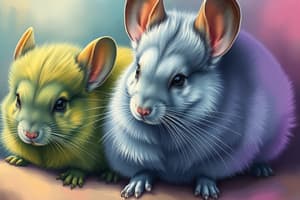Podcast
Questions and Answers
What is the main reason for the decline in chinchilla population?
What is the main reason for the decline in chinchilla population?
- Competition with other species
- Habitat loss
- Disease
- Hunting for fur (correct)
What is the name of the people after whom chinchillas are named?
What is the name of the people after whom chinchillas are named?
- Chincha people (correct)
- Inca people
- Aztec people
- Mayan people
What is the maximum elevation at which chinchillas are known to live?
What is the maximum elevation at which chinchillas are known to live?
- 2,000 ft
- 5,000 ft
- 10,000 ft
- 14,000 ft (correct)
What is the name of the organization that lists chinchillas as Endangered?
What is the name of the organization that lists chinchillas as Endangered?
What is the main interest in chinchillas by researchers?
What is the main interest in chinchillas by researchers?
What is the name of the species of chinchilla that is currently facing extinction?
What is the name of the species of chinchilla that is currently facing extinction?
What is the primary use of domesticated chinchillas descended from Chinchilla lanigera?
What is the primary use of domesticated chinchillas descended from Chinchilla lanigera?
What is the most effective antibiotic for treating digestive problems in chinchillas?
What is the most effective antibiotic for treating digestive problems in chinchillas?
What is the breeding season for chinchillas?
What is the breeding season for chinchillas?
Flashcards are hidden until you start studying
Study Notes
Chinchillas: The Endangered Rodent Genus
- Chinchillas are crepuscular rodents native to the Andes mountains in South America.
- They have the densest fur of all mammals that live on land, with their bodies covered in 20,000 hairs, and are named after the Chincha people of the Andes.
- Chinchillas were hunted for their ultra-soft fur, leading to a population decline, and most chinchillas used by the fur industry are now farm-raised.
- The two living species of chinchilla are Chinchilla chinchilla and Chinchilla lanigera, with the former currently facing extinction.
- Chinchillas live in colonies called "herds" at high elevations up to 4,270 m (14,000 ft) and are known to eat plant leaves, fruits, seeds, and small insects.
- Chinchillas are agile jumpers and can jump up to 1.8 m (6 ft) and have predators such as birds of prey, skunks, felines, snakes, and canines.
- Both species of chinchilla are currently listed as Endangered by the IUCN Red List of Threatened Species.
- Chinchilla fur trade on an international level goes back to the 16th century, and their use for fur led to the extinction of one species and put serious pressure on the other two.
- Domesticated chinchillas descended from Chinchilla lanigera are popular pets, though they require extensive exercise and dental care, and a temperature-controlled environment.
- Chinchillas have been used in research since the 1950s, with the prime interest in chinchillas by researchers being their auditory system.
- Chinchillas may be treated with chloramphenicol, neomycin, or spectinomycin for digestive problems, while colistin can be an effective antibiotic.
- Sick chinchillas may stop eating if they are stressed, and chinchillas are known to be disturbed by a change of diet in their breeding seasons of February to March and August to September.
Studying That Suits You
Use AI to generate personalized quizzes and flashcards to suit your learning preferences.


